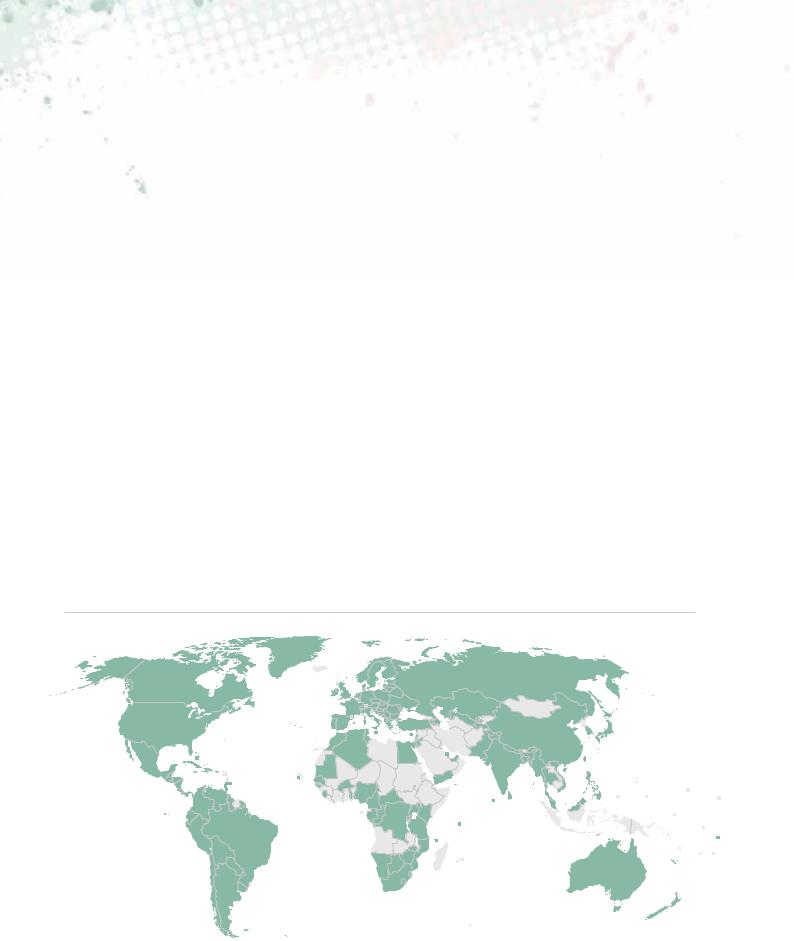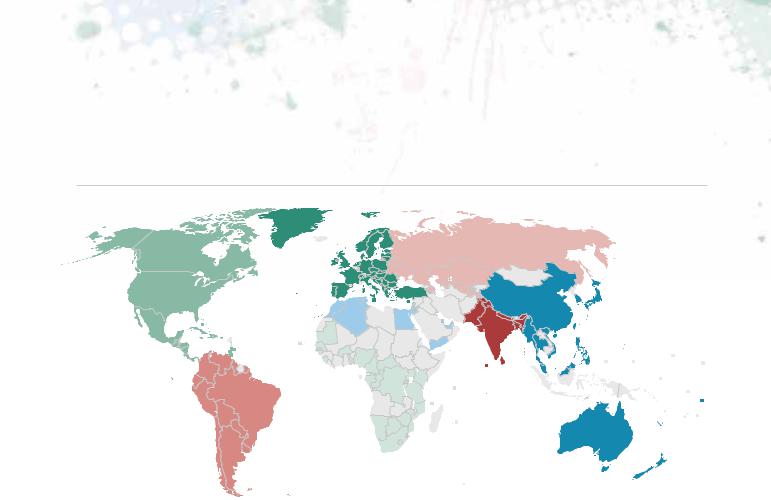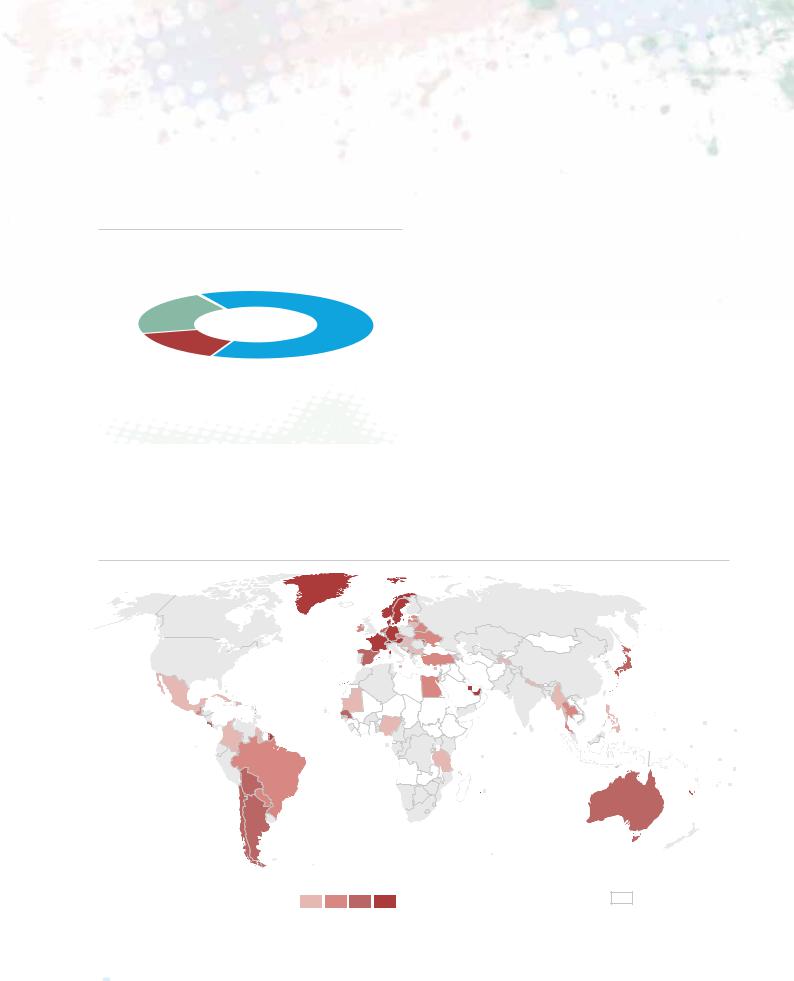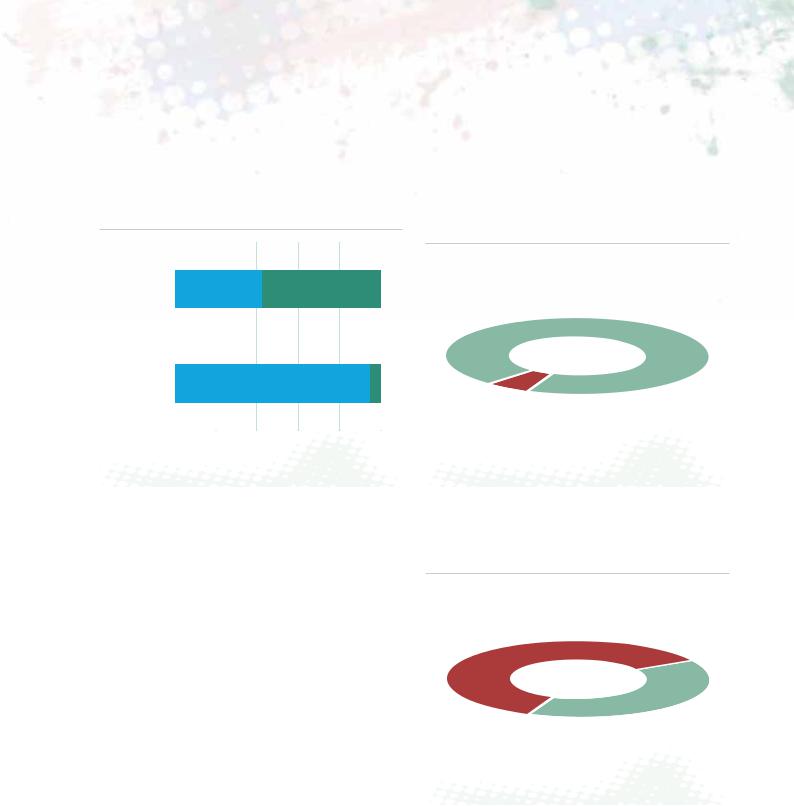
Vsemirny_doklad_o_torgovle_lyudmi_2015
.pdf
METHODOLOGY
QUANTITATIVE DATA COLLECTION
The data collection for the Global Report on Trafficking in Persons has a dual objective: To achieve the broadest possible geographical coverage by using the most solid information available. While the geographical coverage is crucial for a report that is global in scope, the solidity of information is equally important as UNODC’s intention is to produce a report that is reliable and accurate.
The statistical information was collected by UNODC in two ways: through a short, dedicated questionnaire7 distributed to Governments and by the collection of official information available in the public domain (national police reports, Ministry of Justice reports, national trafficking in persons reports, et cetera). All the information that was collected, regardless of source or method, was
Data on offenders
shared with national authorities for verification prior to publication of this report.
Some countries were not covered by the data collection. These countries did not respond to the questionnaire, and in addition, UNODC research efforts to locate official national data on trafficking in persons did not yield any results.
Official statistics from national authorities account for 92 per cent of the information collected for this edition of the Global Report. Intergovernmental organizations supplied 5 per cent, and non-governmental organizations the remaining 3 per cent of the data.
DATA COVERAGE
The time period covered by the data is generally 20102012. Nearly 20 countries also provided information for
|
SUSPECTED PERSONS |
PROSECUTED PERSONS |
CONVICTED PERSONS |
|
|
|
|
Total number of reported offenders |
33,860 |
34,256 |
13,310 |
|
|
|
|
Gender reported |
29,568 |
10,024 |
4,915 |
|
|
|
|
Citizenship reported |
|
|
5,747 |
Data on victims
Total number of reported victims |
40,177 |
Age reported |
34,888 |
|
|
Gender reported |
33,111 |
|
|
Age and gender reported |
31,766 |
|
|
Citizenship reported |
27,052 |
|
|
Countries of repatriation reported (for national victims trafficked abroad) |
4,441 |
|
|
Form of exploitation reported |
30,592 |
|
|
Gender reported according to form of exploitation |
22,405 |
7Available at the Global Report website, http://www.unodc.org/glotip.
17

GLOBAL REPORT ON TRAFFICKING IN PERSONS 2014
the year 2013, and this is normally included in the analysis. Some trend presentations employ data collected for previous UNODC reports on trafficking in persons; in these cases, the sources are specified.
Reporting from Member States is not uniform. While the questionnaire provides a standard set of indicators, many countries report only partially. For example, some countries may provide citizenships for both offenders and victims, others for victims only, and yet others may only report the gender or age profile of the victims. As a result, the amounts of data that form the basis for the different analyses vary. Below is a breakdown of the data that countries reported to UNODC for each indicator.
These figures represent officially detected offenders and victims. These are persons who have been in contact with an institution – the police, border control, immigration authorities, social services, shelters run by the state or by NGOs, international organizations, et cetera - as a result of their involvement (or potential involvement in the case of suspect offenders, and persons in countries that report data on possible or probable victims of trafficking) in trafficking in persons situations. As for any crime, there is a large and unknown ‘dark figure’ of criminal activity that is never officially detected. As such, the figures reported here do not reflect the real extent of trafficking in persons, but rather a sample of the population of victims and offenders that is used to analyse patterns and flows of trafficking in persons.
In terms of geographical coverage, information has been collected from 128 countries for this edition of the Global Report. Specific country-level coverage is indicated in the table and map at the end of this section. All regions are covered, although the amount and solidity of the data varies between regions and subregions. Broadly speaking, Europe and Central Asia as well as the Americas have solid data coverage that allows for detailed analyses. Asia and the Pacific, and particularly Africa and the Middle East, are covered, but with significant room for improvement in terms of data quality and quantity.
All the information that was collected for and used in this Report is presented in the country profiles8 which also specify the information sources.
8Available at the Global Report website, http://www.unodc.org/glotip.
QUALITATIVE DATA – THE ‘COURT CASES’
As explained above, the main data source for the Global Report is statistical criminal justice data officially reported to UNODC by Member States. This data forms the basis for most of the analyses presented in the Report. However, in order to go beyond the statistics, for this edition of the Report, UNODC invited Member States to submit five cases of trafficking in persons that had recently been prosecuted in their jurisdiction.9 Member States used their own discretion when selecting whether to contribute and which cases to include. This means that cases were not necessarily prosecuted under Trafficking in Persons Pro- tocol-aligned legislation.
This call resulted in some 115 case briefs from nearly 30 different countries across six of the eight subregions used in the Report. These briefs will be referred to as the ‘court cases’ throughout the Report. About half of the cases were submitted by countries in Europe and Central Asia, and more than a quarter by countries in the Americas. Relatively few Asian and African cases were received.
The submitted material was not uniform, and there were often information gaps that made coding, comparison and analysis challenging. Moreover, the case sample is relatively small and not necessarily representative of the global manifestations of trafficking in persons. Therefore, it cannot be used to draw solid conclusions.
Regardless of the limitations, the wealth of information contained in these real-world cases can enrich our understanding of the patterns and flows of this crime. These cases illustrate some of the many ways in which trafficking in persons is planned and executed in diverse locations, and how criminal justice systems across many jurisdictions are tackling it. Information from the court cases will be presented alongside the quantitative data where relevant throughout the Report. When cases are discussed, the name of the submitting country is stated, but the names of other countries involved in the cases have been omitted.
9Additionally, the UNODC Human Trafficking Case Law Database contains more than 1,000 case briefs from nearly 100 different jurisdictions.
18

ORGANIZATION OF THE REPORT
The report consists of two main analytical chapters. Chapter I provides a global overview of the patterns and flows of trafficking in persons. It also includes an extensive analysis of the role of organized crime elements in the trafficking crime, and an overview of the status of country-level legislation and responses to the trafficking crime. Chapter II analyses patterns and flows of trafficking in persons, as well as the responses to the crime, from a regional perspective. Additionally, the country profiles, which present the country-level information that was collected for this Report, are available on the Report website at www.unodc. org/glotip. These information sheets are divided into four main sections: the country’s legislation on trafficking in persons; suspects and investigations; victims; and any additional information on the institutional response.
The 128 countries covered have been categorized into four regions: Europe and Central Asia, the Americas, South and East Asia and the Pacific, and Africa and the Middle East. The order of presentation is based on the size of the
Methodology
sample used for the analysis in each region, with Europe and Central Asia having the highest number of victims reported to UNODC during the period considered. The regional groupings are then further divided into two subregions when data coverage allows and doing so helps facilitate more extensive analysis. Europe and Central Asia consists of Western and Central Europe, as well as Eastern Europe and Central Asia. The Americas consists of North and Central America and the Caribbean, as well as South America. South Asia, East Asia and the Pacific consists of South Asia as well as East Asia and the Pacific. Africa and the Middle East consists of North Africa and the Middle East, as well as Sub-Saharan Africa.
Countries covered by the data collection for this report
Sciences Po - Atelier de cartographie, 2014
Source: UNODC.
Note: The boundaries shown on this map do not imply official endorsement or acceptance by the United Nations. Dashed lines represent undetermined boundaries. The dotted line represents approximately the Line of Control in Jammu and Kashmir agreed upon by India and Pakistan. The final status of Jammu and Kashmir has not yet been agreed upon by the parties. The final boundary between the Sudan and South Sudan has not yet been determined.
19

GLOBAL REPORT ON TRAFFICKING IN PERSONS 2014
Regional and subregional designations used in this report
|
EUROPE |
|
|
|
AND CENTRAL ASIA |
||
|
AFRICA |
SOUTH ASIA, |
|
|
EAST ASIA |
||
|
AND |
||
|
AND THE PACIFIC |
||
AMERICAS |
THE MIDDLE EAST |
||
|
|||
|
|
||
Sciences Po - Atelier de cartographie, 2014
|
North and Central America and the Caribbean |
|
North Africa and the Middle East |
|
|
||
|
South America |
|
Sub-Saharan Africa |
|
Western and Central Europe |
|
South Asia |
|
|
||
|
Eastern Europe and Central Asia |
|
East Asia and the Pacific |
|
|
Source: UNODC.
Note: The boundaries shown on this map do not imply official endorsement or acceptance by the United Nations. Dashed lines represent undetermined boundaries. The dotted line represents approximately the Line of Control in Jammu and Kashmir agreed upon by India and Pakistan. The final status of Jammu and Kashmir has not yet been agreed upon by the parties. The final boundary between the Sudan and South Sudan has not yet been determined.
20

AFRICA AND THE MIDDLE EAST
38 states out of the 66 UN Member States in the region
AMERICAS
29 states out of the 35 UN Member States in the region
EUROPE AND CENTRAL ASIA
43 states out of the 53 UN Member States in the region
SOUTH ASIA, EAST ASIA AND
THE PACIFIC
18 states out of the 39 UN Member States in the region
North Africa and |
|
North and Central |
|
Western and |
Eastern Europe |
East Asia and |
South Asia |
|
Sub-Saharan Africa |
America and the |
South America |
||||||
the Middle East |
Central Europe |
and Central Asia |
the Pacific |
(6 countries) |
||||
(total: 27) |
Caribbean |
(total: 11) |
||||||
(11 countries) |
(total: 34) |
(total: 9) |
(total: 12) |
|
||||
|
(total: 18) |
|
|
|||||
|
|
|
|
|
|
|
||
|
|
|
|
|
|
|
|
|
Algeria |
Botswana |
Bahamas |
Argentina |
Albania |
Armenia |
Australia |
Bangladesh |
|
|
|
|
|
|
|
|
|
|
Bahrain |
Burkina Faso |
Barbados |
Bolivia (Plurinational |
Austria |
Azerbaijan |
Brunei Darussalam |
India |
|
State of) |
||||||||
|
|
|
|
|
|
|
||
|
|
|
|
|
|
|
|
|
Egypt |
Cameroon |
Canada |
Brazil |
Bosnia and |
Belarus |
China |
Maldives |
|
Herzegovina |
||||||||
|
|
|
|
|
|
|
||
|
|
|
|
|
|
|
|
|
Israel |
Cabo Verde |
Costa Rica |
Chile |
Bulgaria |
Kazakhstan |
Japan |
Nepal |
|
|
|
|
|
|
|
|
|
|
Jordan |
Central African |
Cuba |
Colombia |
Croatia |
Republic of Mol- |
Malaysia |
Pakistan |
|
Republic |
dova |
|||||||
|
|
|
|
|
|
|||
|
|
|
|
|
|
|
|
|
Lebanon |
Comoros |
Dominican Republic |
Ecuador |
Cyprus |
Russian Federation |
Myanmar |
Sri Lanka |
|
|
|
|
|
|
|
|
|
|
Morocco |
Democratic Repub- |
El Salvador |
Guyana |
Czech Republic |
Tajikistan |
New Zealand |
|
|
lic of the Congo |
|
|||||||
|
|
|
|
|
|
|
||
Qatar |
Gabon |
Grenada |
Paraguay |
Denmark |
Ukraine |
Philippines |
|
|
|
|
|
|
|
|
|
|
|
Tunisia |
Gambia |
Guatemala |
Peru |
Estonia |
Uzbekistan |
Republic of Korea |
|
|
|
|
|
|
|
|
|
|
|
United Arab |
Guinea-Bissau |
Haiti |
Uruguay |
Finland |
|
Samoa |
|
|
Emirates |
|
|
||||||
|
|
|
|
|
|
|
||
|
|
|
|
|
|
|
|
|
Yemen |
Kenya |
Honduras |
Venezuela (Bolivar- |
France |
|
Thailand |
|
|
ian Republic of) |
|
|
||||||
|
|
|
|
|
|
|
||
|
Lesotho |
Jamaica |
|
Germany |
|
Viet Nam |
|
|
|
|
|
|
|
|
|
|
|
|
Mauritania |
Mexico |
|
Greece |
|
|
|
|
|
|
|
|
|
|
|
|
|
|
Mozambique |
Nicaragua |
|
Hungary |
|
|
|
|
|
|
|
|
|
|
|
|
|
|
Namibia |
Panama |
|
Ireland |
|
|
|
|
|
|
|
|
|
|
|
|
|
|
Nigeria |
St. Vincent and |
|
Italy |
|
|
|
|
|
Grenadines |
|
|
|
|
|||
|
|
|
|
|
|
|
||
|
|
|
|
|
|
|
|
|
|
Republic of Congo |
Trinidad and Tobago |
|
Latvia |
|
|
|
|
|
|
|
|
|
|
|
|
21 |
Methodology |

22
GLOBAL REPORT ON TRAFFICKING IN PERSONS 2014
AFRICA AND THE MIDDLE EAST |
AMERICAS |
EUROPE AND CENTRAL ASIA |
SOUTH ASIA, EAST ASIA AND |
|||||
|
|
|
|
|
|
THE PACIFIC |
||
38 states out of the 66 UN Member States |
29 states out of the 35 UN Member States |
43 states out of the 53 UN Member States |
18 states out of the 39 UN Member States |
|||||
in the region |
in the region |
in the region |
in the region |
|||||
|
|
|
|
|
|
|
|
|
North Africa and |
|
North and Central |
|
Western and |
Eastern Europe |
East Asia and |
South Asia |
|
Sub-Saharan Africa |
America and the |
South America |
||||||
the Middle East |
Central Europe |
and Central Asia |
the Pacific |
(6 countries) |
||||
(total: 27) |
Caribbean |
(total: 11) |
||||||
(11 countries) |
(total: 34) |
(total: 9) |
(total: 12) |
|
||||
|
(total: 18) |
|
|
|||||
|
|
|
|
|
|
|
||
|
|
|
|
|
|
|
|
|
|
Rwanda |
United States of |
|
Lithuania |
|
|
|
|
|
America |
|
|
|
|
|||
|
|
|
|
|
|
|
||
|
Senegal |
|
|
Malta |
|
|
|
|
|
|
|
|
|
|
|
|
|
|
Seychelles |
|
|
Montenegro |
|
|
|
|
|
|
|
|
|
|
|
|
|
|
Sierra Leone |
|
|
Netherlands |
|
|
|
|
|
|
|
|
|
|
|
|
|
|
South Africa |
|
|
Norway |
|
|
|
|
|
|
|
|
|
|
|
|
|
|
Swaziland |
|
|
Poland |
|
|
|
|
|
|
|
|
|
|
|
|
|
|
Togo |
|
|
Portugal |
|
|
|
|
|
|
|
|
|
|
|
|
|
|
Uganda |
|
|
Romania |
|
|
|
|
|
|
|
|
|
|
|
|
|
|
United Republic of |
|
|
Serbia |
|
|
|
|
|
Tanzania |
|
|
|
|
|
||
|
|
|
|
|
|
|
||
|
|
|
|
|
|
|
|
|
|
Zimbabwe |
|
|
Slovakia |
|
|
|
|
|
|
|
|
|
|
|
|
|
|
|
|
|
Slovenia |
|
|
|
|
|
|
|
|
|
|
|
|
|
Spain
Sweden
Switzerland
The former Yugoslav Republic of Macedonia
Turkey
United Kingdom of
Great Britain and
Northern Ireland

CHAPTER I
GLOBAL OVERVIEW
In the United Nations Global Plan of Action to Combat Trafficking in Persons,1 Member States requested for the present report to focus on the patterns and flows of trafficking in persons. ‘Patterns’ refer to the profiles of traffickers and victims; that is, their citizenship, age and gender as well as the forms of exploitation. ‘Flows’ refer to the geographic dimension of trafficking, with a ‘flow’ defined as one origin country and one destination country with at least five detected victims during the 2010-2012 reporting period.2
A snapshot of the data shows that most of the offenders are men, while most of the detected victims are female (mainly women, but also a significant number of underage girls). Trafficking is a transnational crime that is often carried out domestically or within a given subregion, and most offenders are convicted in their countries of citizenship. Victims, on the other hand, are often foreigners in the country where their exploitation was detected. Trafficking flows are usually confined to a geographically limited area, either within a country or between neighbouring or relatively close countries.
That said, a greater proportion of women are convicted of trafficking in persons than of nearly any other crime, and the detection of male victims is increasing. Many countries convict a significant number of foreigners of trafficking in persons, and many victims are not trafficked abroad but exploited in their own countries. Although transregional trafficking is less common than the domestic or intraregional types, it still accounts for nearly a quarter of all trafficking flows.
This chapter seeks to untangle some of this complexity. It will first present a global overview of patterns and flows, and then, a discussion on markets and organized crime as they relate to trafficking in persons. The chapter closes with an overview of the legislative and criminal justice responses to this crime across the world.
1A/RES/64/293.
2This also includes flows where the country of origin and destination is the same, thus the case of domestic trafficking.
TRAFFICKERS
In order to understand the crime of trafficking in persons, it is crucial to know who the offenders are. Analysing the citizenship and gender of traffickers can help generate a broader understanding of the profiles of traffickers and their networks, as well as on how they operate. As trafficking in persons is a crime that is often transnational, the question of traffickers’ citizenship is highly relevant, particularly when it comes to cross-border trafficking as there is often a citizenship link between traffickers and victims. Moreover, the issue of female involvement in trafficking in persons is also pertinent.
Information on the citizenship of persons convicted3 of trafficking in persons was provided by 64 countries, covering a total of 5,747 offenders. Information on the gender of suspected, prosecuted and/or convicted offenders was provided by 43, 59 and 64 countries respectively, covering 29,568 persons suspected, 4,915 persons convicted of and 10,024 persons prosecuted for trafficking in persons. The data covers the 2010-2012 period (or more recent).
Citizenship profiles of traffickers
The aggregated citizenship profiles of the people convicted of trafficking in persons show that most offenders are citizens of the country where they were convicted. This is true for more than 6 in 10 convicted traffickers globally. It is reasonable to expect that the majority of people convicted of nearly any crime would be citizens of the prosecuting country. Even though international mobility is high, most people still live and operate mainly within their own countries.
While the majority of offenders are citizens of the country where they were convicted, about 35 per cent of convicted traffickers are foreigners in those countries. This is a larger
3Including profile information on persons investigated for trafficking, or on the citizenships of those prosecuted for trafficking (as is done for the gender profile) would have yielded more data. However, using citizenship information only on offenders convicted in the first instance is more solid and limits possible biases related to the potential targeting of particular citizenships within some criminal justice systems.
23

GLOBAL REPORT ON TRAFFICKING IN PERSONS 2014
FIG. 1: Citizenship of convicted traffickers globally, 2010-2012 (or more recent); shares of local and foreign nationals (relative to the country of conviction)
FOREIGNERS FROM COUNTRIES NATIONALS |
||
IN THE SAME REGION |
64% |
|
22% |
||
|
||
FOREIGNERS FROM OTHER REGIONS
14%
Source: UNODC elaboration on national data.
share of convicted foreigners than what is typically seen for most other crimes, for which foreign citizens generally comprise approximately 10 per cent of those convicted.4
The high share of foreign involvement should not be surprising considering the often transnational nature of this crime. As will be presented later in the Report, about two thirds of the human trafficking victims reported to UNODC over the 2010 – 2012 period were exploited in cases that involved at least one border crossing.
When foreign offenders are involved, they tend to come from countries that are relatively close, geographically, to the prosecuting country. Some 22 per cent of those convicted of trafficking in persons are foreigners from countries within the region where they were prosecuted, while 14 per cent are citizens of countries in other regions. This means that in a given country in Asia, for example, it is reasonable to expect that most of the people convicted of trafficking in persons will be citizens of that country. The second largest group will be other Asians, and a relatively small share will be non-Asian foreigners.
This distribution largely follows the breakdown of global trafficking flows, as long-distance (transregional) traffick-
MAP 1: Share of foreign offenders among the total number of persons convicted of trafficking in persons, by country, 2010-2012
Sciences Po - Atelier de cartographie, 2014
Share of foreign offenders
countries not covered
0 |
5 25 60 100 |
|
data not available |
Source: UNODC.
Note: The boundaries shown on this map do not imply official endorsement or acceptance by the United Nations. Dashed lines represent undetermined boundaries. The dotted line represents approximately the Line of Control in Jammu and Kashmir agreed upon by India and Pakistan. The final status of Jammu and Kashmir has not yet been agreed upon by the parties. The final boundary between the Sudan and South Sudan has not yet been determined.
4United Nations Surveys on Crime Trends and the Operations of Criminal Justice Systems (CTS), available at: http://www.unodc.org/ unodc/en/data-and-analysis/statistics/data.html.
24

|
Global overview |
|
|
|
|
Origin or destination country? |
more typical destination countries. While countries |
|
In the context of discussing trafficking flows, the |
play both roles, the majority of the trafficking flows |
|
are either outbound (in the case of a more typical |
|
|
question of whether a given country is more of an |
origin country) or inbound (more typical destina- |
|
origin or destination country is very relevant. |
tion). |
|
Understanding whether a country ‘sends’ or ‘receives’ |
A more typical country of origin of cross-border |
|
more trafficking victims is helpful for discerning |
|
|
transnational trafficking dynamics. It is not possi- |
trafficking may detect some foreign victims who are |
|
ble, however, to make a rigid distinction between |
being exploited within its territory, but the out- |
|
origin and destination countries. As with any aggre- |
bound flow of that country’s citizens for exploita- |
|
gation, such a broad categorization runs the risk of |
tion in other countries will be far larger. |
|
obscuring important details and highlighting obser- |
Out of the 78 countries that provided information |
|
vations that may not be accurate at the micro level. |
|
|
concerning the citizenship of the convicted offend- |
|
|
Moreover, domestic trafficking, which is detected in |
|
|
ers, 37 were considered to be more typical origin |
|
|
most countries across the world, makes countries |
|
|
countries of cross-border trafficking, whereas 41 |
|
|
origins and destinations simultaneously. |
|
|
were considered more typical destination countries. |
|
|
Even if only cross-border trafficking is considered, |
|
|
While it should be kept in mind that the diverse |
|
|
countries may belong to both categories. Indeed, |
national situations cannot be fully captured by such |
|
most countries do, as they detect both outbound |
a broad categorization, when looking at the global |
|
trafficking of own citizens and inbound trafficking |
level, classifying countries as more typical origin or |
|
of foreigners. Only a very few are exclusively origin |
destination countries of trafficking in persons is |
|
or destination countries. For this reason, countries |
nonetheless very useful for trying to understand |
|
may be thought of as being more typical origin or |
and describe typical cross-border trafficking flows. |
|
|
|
|
ing is much less frequently detected than domestic or subregional trafficking. However, it should be noted that the share of convicted own citizens among the total number of trafficking offenders is generally much higher than the share of domestic trafficking detected in a given country. This could imply that domestic trafficking - which happens within the borders of one country - is mainly organized by citizens of that country.
But even so, local citizens are not only engaged in domestic trafficking. Many of those who were convicted in their own countries during 2010 – 2012 were taking part in cross-border trafficking, be it subregional or transregional. Convicted local citizens could be involved in both domestic and cross-border trafficking in some way, for example, as recruiters, transporters, guards or exploiters.
The court cases submitted to UNODC by Member States5 include an illustrative case from Latvia, where two Latvian men were convicted of trafficking Latvian women to a different country in Western Europe for sexual exploitation. The offenders recruited the victims, deceived them regarding the working conditions they could expect in
5For more information on the court cases, please refer to the section on Methodology.
their destination country by promising a reasonable salary and reassuring them that they would not be involved in prostitution, and then transported the victims across the borders to accomplices. Once in the destination country, the victims were exploited in prostitution against very little pay. In this scheme, the offenders received money from their partners to cover their costs. From the available information, it seems that the convicted men were ‘subcontracted’ to recruit and transport victims for a larger, foreign-based operation. This shows how convicted persons reported as ‘local offenders’ may actually be involved in cross-border operations.
Though there are some differences, the overall pattern of offender citizenships in the case of cross-border trafficking holds true globally. But if a distinction is made between origin and destination countries for cross-border trafficking, the picture changes dramatically.
While countries that are more typically origin countries for cross-border trafficking convict mainly local citizens (about 95 per cent of all convictions), more typical destination countries convict fewer own citizens than foreigners of trafficking in persons (58 per cent foreigners, 42 per cent locals). Foreign participation is therefore a key
25

GLOBAL REPORT ON TRAFFICKING IN PERSONS 2014
FIG. 2: Distribution of national and foreign offenders among countries of origin and destination of cross-border trafficking, 2010-2012
|
NATIONAL |
OFFENDERS |
|
|
|
|
Countries of |
|
|
|
|
|
|
destination |
|
42% |
|
|
58% |
|
|
|
|
|
|
||
|
|
|
FOREIGN OFFENDERS |
|
||
Countries of |
|
|
|
|
|
|
|
|
|
95% 5% |
|||
origin |
|
|
|
|||
|
|
|
|
|
|
|
0% |
20% |
40% |
60% |
80% |
100% |
|
Source: UNODC elaboration on national data.
FIG. 3: Convictions of foreign citizens (relative to the convicting country) by countries of origin and destination of cross-border trafficking,
2010-2012
COUNTRIES OF DESTINATION
95%
COUNTRIES OF ORIGIN
5%
Source: UNODC elaboration on national data.
characteristic of cross-border trafficking in persons in destination countries, but not in origin countries.
Aqualitative analysis of the cross-border trafficking cases within the set of court cases shows that, while victims are normally recruited by local citizens in the victims’ own country (origin country), the traffickers who carry out the exploitation in the destination country may be either local citizens of these destination countries or foreigners. Moreover, as shown in the chart above, 58 per cent of traffickers in destination countries are not citizens of the country where they were convicted. Only 5 per cent of all the traffickers convicted in origin countries are foreigners in these countries. While there is insufficient evidence to draw authoritative conclusions, on the base of the official data collected, it can be hypothesized that traffickers in destination countries are often able to recruit or maneuver local traffickers in origin countries.
Acloser look at only the foreign citizens convicted of trafficking in persons shows that 95 per cent are convicted in destination countries. For local offenders, on the other hand, the distribution between origin countries and destinations is relatively equal. In other words, national offenders convicted of trafficking in persons may be found in origin and destination countries in similar proportions.
These findings seem to indicate that while recruitments in origin countries are largely carried out by citizens of those countries, the exploitation schemes in destination
FIG. 4: Convictions of local citizens (relative to the convicting country) by countries of origin and destination of cross-border trafficking, 2010-2012
COUNTRIES OF ORIGIN
60%
COUNTRIES OF DESTINATION
40%
Source: UNODC elaboration on national data.
countries are likely to involve more transnational operators.
Many foreign traffickers also seem to frequently traffic victims from their own country of citizenship. This is confirmed by a clear statistical correlation between the citizenships of victims and offenders in selected destinations of cross-border trafficking. Moreover, in the court cases, many of the case briefs indicated that the citizenships of both trafficker(s) and victim(s) matched. This was particularly apparent when the offender was prosecuted in the destination country for the act of recruitment
26
